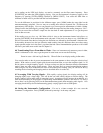18
The difference is caused by the different way telephone and radio people denote SSB cannel frequency.
When comparing a SSB radio frequency with a HP3586 frequency on LSB the HP3586 will have a fixed
negative offset from the receiver’s whose value depends on the filter that is selected in the HP3586. On
USB the HP3586’s frequency offset will be positive by the same filter offset. This is because the HP3586
in the selective modes defines a cannel by its center frequency where SSB receivers and transmitters use
the convention of defining the channel by the carrier frequency.
Filter offset values can be used to obtain the carrier frequency used by radio SSB transmitters and receiver
by adding or subtracting it from the HP3586 display frequency readings. These carrier offset numbers are
shown below for each of the HP3586 filters that can be used for SSB:
FILTER BAND WIDTH CARRIER OFFSET
1740Hz 1350Hz
2000Hz 1500Hz
3100Hz 1850Hz
9.4 Setting a AM Transmitter’s Carrier to a SSB frequency - To better understand this let’s go
through an example of zero beating an AM transmitter with a SSB signal. Assume I want to check into the
Collins Collectors Association net on LSB at 3895kHz. The net control operator and most of the members
are on LSB but welcome anyone to check in on AM as long as they have a stable signal and are zero beat
with the net control operator so they can be copied on LSB by the net members. Tonight there is a QSO
down a few KHz below the net so the net control has moved the net up an unknown number of Hz and it’s
hard to determine his exact frequency because I’m using my 75A4 receiver with an analog frequency dial.
I can usually get to within 100Hz using it but even that will cause complaints by those on LSB, especially
those that don’t like AM. So I want to get as close as possible to their frequency with my BC-610F AM
transmitter which is hooked to a HP3586.
I tune close to the SSB signal of the net control operator using a frequency keyboard entry then the method
describer in section 4.11 of chapter 4. I next enter into my hand held calculator the frequency displayed on
my HP3586, which is 3896KHz. Since I’m using my 3100Hz filter and on LSB, I use my calculator to add
a carrier offset of 1850Hz to the HP3586C’s frequency of 3896Kz to get the SSB stations carrier frequency
of 3897.850KHz. I then enter the calculated SSB net’s carrier frequency into my HP3586C using the
following commands, press [FREQ], enter 3897.850 on the keyboard, press [KHz], and finally press
[MEAS CONT] to place the new filter center RF frequency and internal tracking oscillator frequency into
the HP3586’s frequency register. I now turn down the volume of my HP3585’s speaker since the SSB
signal will be detuned by 1850Hz and use my 75A4 receiver to monitor the net. Now the filter center
frequency and the frequency of the rear panel output to my transmitter is right on the SSB net’s frequency
so my AM transmitter’s carrier frequency will be zero beat with the net control’s frequency. Then most
stations on the net will not even realize I’m using AM. This example should illustrate a way to work
around the different methods of measuring SSB channel frequency used by telephone and radio technicians
using the HP3586C.
9.4 Frequency Shift During Auto Cal - When transmitting AM to a SSB station using a HP-3586
with the instrument’s auto cal function is on, the instrument’s output frequency will change about 100Hz
up and down in frequency during the 3 second auto cal cycle. For this reason I find it best to press [AUTO
CAL] to turn off auto cal during AM transmissions. I usually leave auto cal off after the instrument has
warmed up for a half hour when transmitting to SSB stations just after I have set my carrier frequency.
Auto cal is only necessary after a large change in frequency and during level measurements.


















